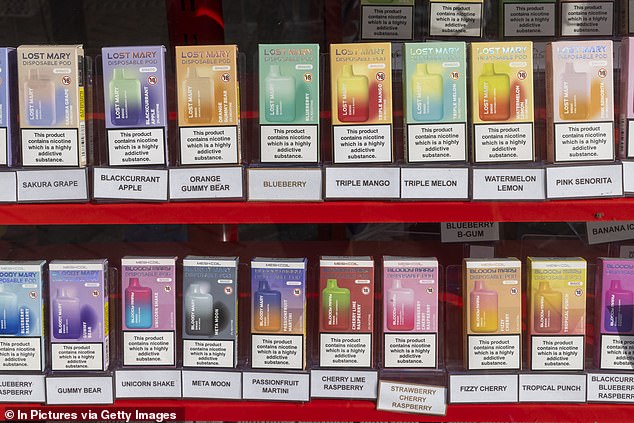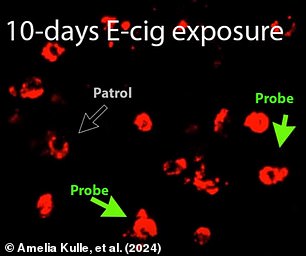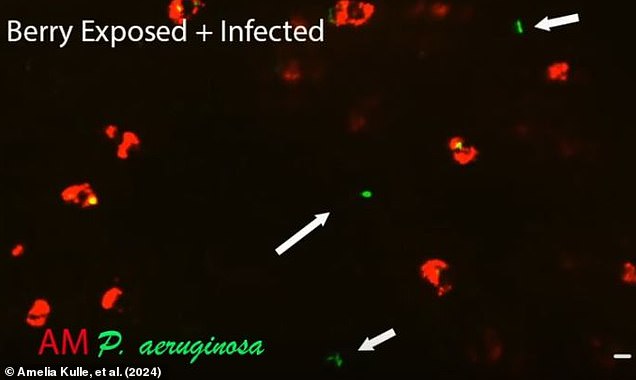Warning for vapers: Scientists reveal e-cigarette flavor could damage your lungs’ immune cells and make it harder to fight infections
It’s no secret that smoking e-cigarettes can lead to long-term health problems.
But scientists now say some vape flavors could be much worse than others.
Researchers at McGill University in Canada found that berry-flavored e-cigarettes cause more damage to your lungs’ immune cells than other types.
During tests on mice, the researchers found that the sweet vapor interfered with cells called alveolar macrophages and prevented them from clearing bacteria.
The researchers say this can lead to serious illness, respiratory distress and even death.
However, the scientists found that mice exposed to tasteless vapors or menthol vapors did not experience the same harmful effects.
This suggests that some chemicals used to flavor e-cigarettes may be more harmful to our lung health than others.
However, the researchers emphasize that several vape flavors – not just berry – are packed with chemicals linked to lung damage.
Researchers say berry-flavored vapes could be much more harmful than flavorless or menthol alternatives (stock image)

From menthol to vanilla custard and sour strawberry: there are currently an estimated 40,000 vape flavors on the market worldwide
Co-author of the study, Ajitha Thanabalasuriar from McGill University, told MailOnline: ‘From our research we see that the more complex flavors and additives you add to e-cigarettes, the worse the effects on immunity.’
As the prevalence of vaping among young people increases, there is increasing research suggesting that vaping can be harmful.
In addition to nicotine, which can be harmful to heart health, vapes also contain numerous chemical additives and flavorings.
However, little research has been done on how specific flavorings alter the health effects of e-cigarette use.
To investigate this connection, Dr. Thanabalasuriar and her colleagues looked at how immune cells in mice were affected by different types of vape.
Mice were kept in a box containing either fresh air, berry-flavored e-cigarette vapor, or unflavored e-cigarette vapor for 10 days.
Berry was chosen as the representative flavor due to its popularity among many vape users
The researchers then stained the alveolar macrophages (AMs) so they would show up on a microscope and looked to see if their behavior had changed.
AMs live on the walls of our alveoli, the microscopic sacs in our lungs that allow gases from the air to enter our bloodstream.

Researchers tested how berry and unflavored vapors affected immune cells in our alveoli (illustrated) by exposing mice to continuous e-cigarette vapor for 10 days
As a ‘crossroads’ between our internal organs and the outside world, they are a crucial point for immunity.
To prevent infection, AMs patrol the surface of the alveoli and act as sentinels against incoming pathogens and pollutants.
In the control mice (which were not exposed to fumes), analysis showed that the cells performed their probing, squeezing and patrolling behavior normally.
However, after ten days of continuous exposure to berry-flavored e-cigarettes, the researchers found that AM mobility was significantly reduced.
Instead of searching for pathogens, squeezing through the gaps between the alveoli and patrolling the cell perimeter, the vapor-affected cells remained largely stationary.
When the researchers looked at AMs exposed to tasteless vapors or menthol vapors, they surprisingly found that these cells showed virtually no differences from the control group.
The macrophages continuously exposed to flavorless e-cigarettes for 10 days were found to be as mobile as those in the clean air control group.
Dr. Thanabalasuriar says: ‘The macrophages move through our airways, sucking up dirt and infections. Berry vape but not tasteless hinders this movement.’


After 10 days, immune cells in the alveoli of mice exposed to berry-flavored vapors (right) showed significantly less movement than those of mice exposed to clean air (left)

This graph shows the movement of an immune cell from the alveoli after exposure to air (left) and to vaping for three (middle) or ten (right) days
The findings are concerning for human health because hindering AM movements limits their ability to remove harmful bacteria.
Researchers then infected the test mice with a bacterium called Pseudomonas aeruginosa, a pathogen that infects the alveoli and is common in smokers.
This bacteria poses no threat to healthy humans and mice, which can easily fight the infection.
However, mice exposed to berry-flavored vapor showed significantly higher bacterial counts seven days after exposure to the virus.
By reducing the ability of immune cells to clear the infection, vaping berry-flavored e-cigarettes led to slightly higher death rates among the mice.
The researchers point out that while this may not lead to fatal consequences for humans, it could mean that vapers take longer to clear infections and require more antibiotics to recover.
Dr. Thanabalasuriar says the more flavorings there are in one vape flavor, the greater this effect is likely to be.
And she describes berries as having a “complex” flavor with many different chemicals.
Healthy immune cells (left) quickly cleared away bacteria that could threaten the mice’s lungs, while those exposed to fumes (right) were unable to defend themselves against the infection

Because the researchers only tested berry and menthol vapors, they can’t say which flavors are the most dangerous. However, they point out that the more complex a flavor is, the more likely it is to cause harm (stock image)
“We’ve actually broken down the chemicals in the vapor that make up the berry flavor,” added Dr. Thanabalasuriar to it.
‘The individual chemicals did not have such adverse effects; it had to be the combination.’
However, because only two flavors were tested, the researchers cannot conclude which individual flavors are likely to be the most harmful.
Moreover, because this experiment was only conducted in mice, it is not certain whether the results are directly applicable to humans.
But the researchers still caution that their findings show that more caution may be needed regarding flavored e-cigarettes.
Dr. Thanabalasuriar says, “We have to be careful about the types of flavors we put in these products as they can have harmful effects.
“That’s really the take-home message, especially some of these vaping products that are marketed to children.
“The way they’re sold, the kind of containers they’re sold in – it’s very colorful, it’s very attractive to children, and this could be very bad for our future.”


